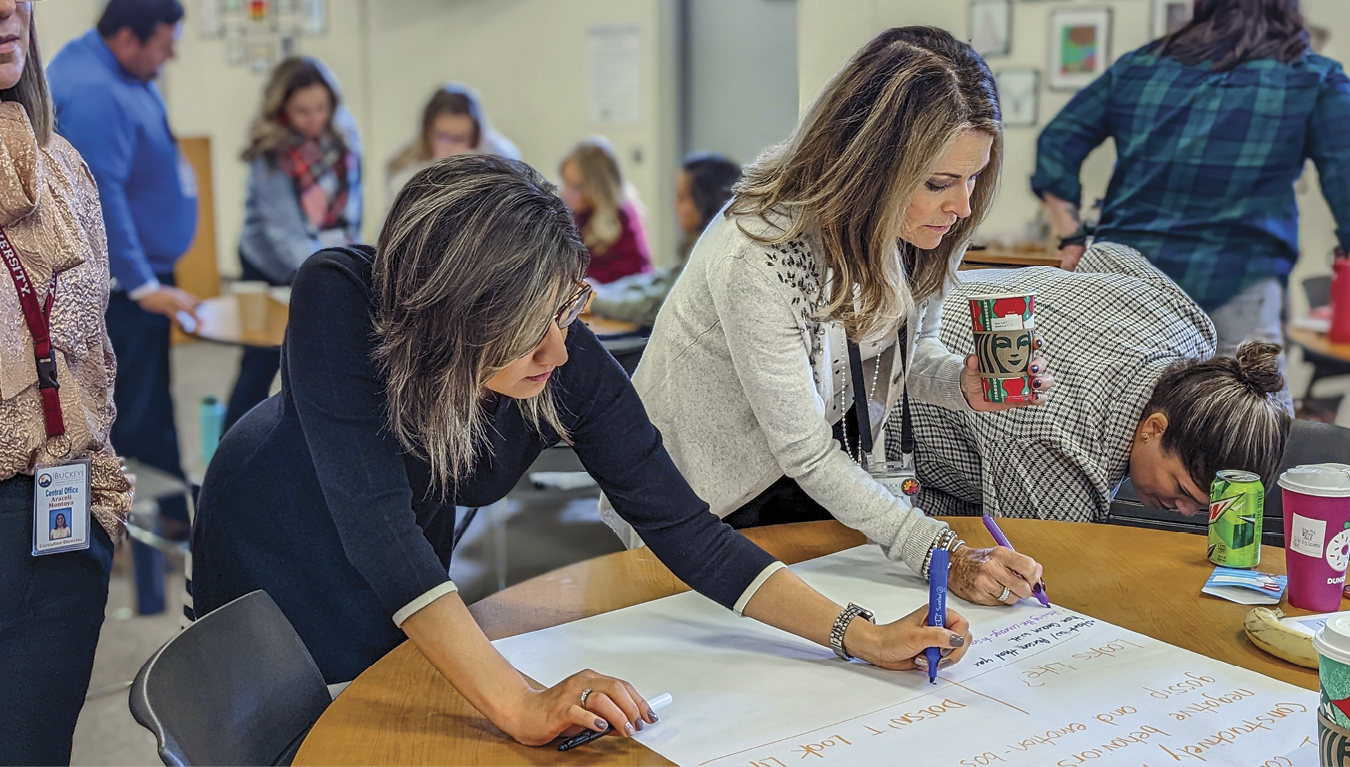Learning Reimagined by Focusing on Flexible Skills
June 01, 2023
AASA Learning 2025 Lighthouse Demonstration System: Buckeye Elementary School District

A single question posed by Kristi Wilson, superintendent of the Buckeye Elementary School District in Arizona, stimulated the district’s bold approach to redesigning and rethinking what school should be: “What does the future hold for our learners?”
It was anything but simple, with the only certainty being uncertainty about what may lie ahead.
The Buckeye district, located about 15 miles from Phoenix, serves approximately 5,900 students in two preschools and eight K-8 schools. All are Title 1 sites with 68 percent of Buckeye’s students qualifying under federal poverty guidelines. Working with local elected officials and business leaders, the district identified specific skills and ways of approaching problems that would enable students to respond to future challenges in their lives.
“We saw the planning process as an opportunity to … change the culture to be future-driven,” says Wilson, the superintendent since 2013. “The new economy means we have to embrace future mindsets.” That means preparing students to recognize problems, figure out how to solve them and set personal goals.
Among the key skills being instilled in Buckeye students are the 16 Habits of Success, which include perseverance, school readiness, sustainability and independence, self-direction and curiosity. The curriculum is aligned with state standards, even if the process looks different.
It appears to be working. Coming out of the first year of the pandemic, the district saw student proficiency on Arizona state assessments in both English and math exceed the state’s growth rate in student achievement. In 2022, the state’s average growth for math was 2 percent, while Buckeye registered a 9 percent growth in that subject. In English language arts, the state average saw a 1 percent growth, compared to the district’s 8 percent gain.
Coding as a Catalyst
Buckeye designed and opened a new building in 2020, the John S. McCain III Elementary School, which enabled district leaders to put their vision into practice, even as other campuses also adapted those future-driven skills. Embedded as a foundation at the school was a focus on technology and coding, driven by an emphasis on computational thinking.
What makes computational thinking appealing, says Dina Cegelka, principal of McCain Elementary, is that “it’s about the problem-solving process,” with applications that extend beyond math and science lessons. “It’s creating processes, which is a selling point for teachers. It’s when do you see patterns, it’s breaking apart problems — these ideas transcend one thing. … They’re gaining habits that are relevant to school and understanding why it matters.”
Coding is in service to the larger goal of having students take charge of their learning and understand how to solve problems. “It’s not an either/or learner model,” Wilson says. “The communication side, with sympathy and empathy, is important.”
Humanities are integrated with C-STEM, which refers to the computer science and STEM disciplines. Students use coding to make games with narratives or apply technology to study a particular topic. Sixth graders used 3-D printers to create Greek columns, while 8th graders developed a game to review key vocabulary in a particular unit and then used the robotic mice to code to the correct answer on the board.
“A lot of jobs will involve technology and coding-related skills,” Wilson says. “The future will involve skills like building algorithms.”
Experimental Learning
To help students on this new path, teachers need to be comfortable with these skills as well. As Cegelka says, training the new cohort of teachers when her school opened its doors was essential. “We were onboarding a whole new staff, creating a culture and norms, as a computer science school. The biggest thing was having a professional development plan in place.”
The goal was to ensure teachers saw themselves as learners first, becoming familiar with the curriculum, playing with the robotics and mastering the instructional tools to help their students integrate technology in their lessons.
“Teaching coding and computer science is a new way of teaching,” Wilson says. “It’s OK if you fail. You fail forward, as part of a growth mindset.”
That willingness to test, experiment and try again is visible as students explore projects of personal interest. The building itself, with its flexible design, lots of glass and spaces outside the classroom for students to collaborate in small and large groups, contributes to the sense of discovery. Some students work at tables with other students, building and programming small robots. Others construct a computer game or design an animated story.
“The glass can open up, but the line of vision doesn’t change,” Cegelka says. “My walls aren’t limiting.” Teachers can think about “where is the best place to do that learning? Sometimes it’s outside. Sometimes it’s in the community hub. The building is another living thing.”
Wider Impact
What happens at John McCain III Elementary School is definitely not staying there.
“We’re bringing its values to other buildings,” Wilson shares.
There are a few ways this has developed.
Wilson explains it this way: “In essence, [the McCain School’s] approach to change management that ensures fidelity, yet doesn’t put unreasonable demands on teachers and students has provided valuable insights for other schools.”
Another example of influence relates to the use of flexible space as the McCain School has served as a demonstration site for other teachers. “One of our newer schools had some flexible and collaborative spaces designed into the building,” the superintendent says, “but teachers needed to see how to use it most effectively.”
MERRI ROSENBERG is a freelance education writer in Ardsley, N.Y.
Author
Roster of Lighthouses
To read the full list of Lighthouse school systems being featured in this series and learn more about becoming a demonstration district, visit aasa.org/learning2025.
Advertisement
Advertisement
Advertisement
Advertisement




